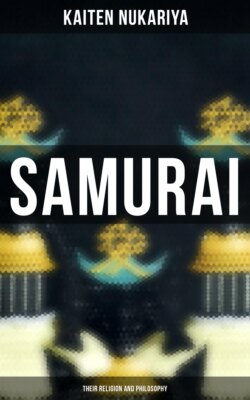Читать книгу Samurai: Their Religion and Philosophy - Kaiten Nukariya - Страница 30
На сайте Литреса книга снята с продажи.
10. Zen after the Downfall of the Ho-Jo Regency.
ОглавлениеTowards the end of the Ho-Jo period,90 and after the downfall of the Regency in 1333, sanguinary battles were fought between the Imperialists and the rebels. The former, brave and faithful as they were, being outnumbered by the latter, perished in the field one after another for the sake of the ill-starred Emperor Go-dai-go (1319-1338), whose eventful life ended in anxiety and despair.
Another teacher who gained lasting influence on the Court is Nan-po, known as Dai-O-Koku-Shi (1235-1308), who was appointed the abbot of the monastery of Man-ju-ji in Kyo to by the Emperor Fushi-mi. One of his disciples, Tsu-o, was the spiritual adviser to both the Emperor Hana-zono (1308-1318) and the Emperor Go-dai-go. And another disciple, Myo-cho, known as Dai-To-Koku-Shi (1282-1337), also was admired by the two Emperors, and created the abbot of Dai-toku-ji, as the founder of a sub-sect of the Rin Zai under the same name. It was for Myo-cho's disciple, Kan-zan (1277 1360), that the Emperor Hana-zono turned his detached palace into a monastery, named Myo-shin-ji, the head temple of a sub-sect of the Rin Zai under the same name.
It was at this time that Japan gave birth to Masa-shige (Kusu-noki), an able general and tactician of the Imperialists, who for the sake of the Emperor not only sacrificed himself and his brother, but by his will his son and his son's successor died for the same cause, boldly attacking the enemy whose number was overwhelmingly great. Masa-shige's loyalty, wisdom, bravery, and prudence are not merely unique in the history of Japan, but perhaps in the history of man. The tragic tale about his parting with his beloved son, and his bravery shown at his last battle, never fail to inspire the Japanese with heroism. He is the best specimen of the Samurai class. According to an old document,91 this Masa-shige was the practiser of Zen, and just before his last battle he called on Chu Tsun (So-shun) to receive the final instruction. "What have I to do when death takes the place of life?" asked Masa-shige. The teacher replied:
"Be bold, at once cut off both ties,
The drawn sword gleams against the skies."
Thus becoming, as it were, an indispensable discipline for the Samurai, Zen never came to an end with the Ho-jo period, but grew more prosperous than before during the reign92 of the Emperor Go-dai-go, one of the most enthusiastic patrons of the faith.
The Shoguns of the Ashi-kaga period (1338-1573) were not less devoted to the faith than the Emperors who succeeded the Emperor Go-dai-go. And even Taka-uji (1338-1357), the notorious founder of the Shogunate, built a monastery and invited So-seki,93 better known as Mu-So-Koku-Shi, who was respected as the tutor by the three successive Emperors after Go-dai-go. Taka-uji's example was followed by all succeeding Shoguns, and Shogun's example was followed by the feudal lords and their vassals. This resulted in the propagation of Zen throughout the country. We can easily imagine how Zen was prosperous in these days from the splendid monasteries94 built at this period, such as the Golden Hall Temple and the Silver Hall Temple that still adorn the fair city of Kyo-to.
